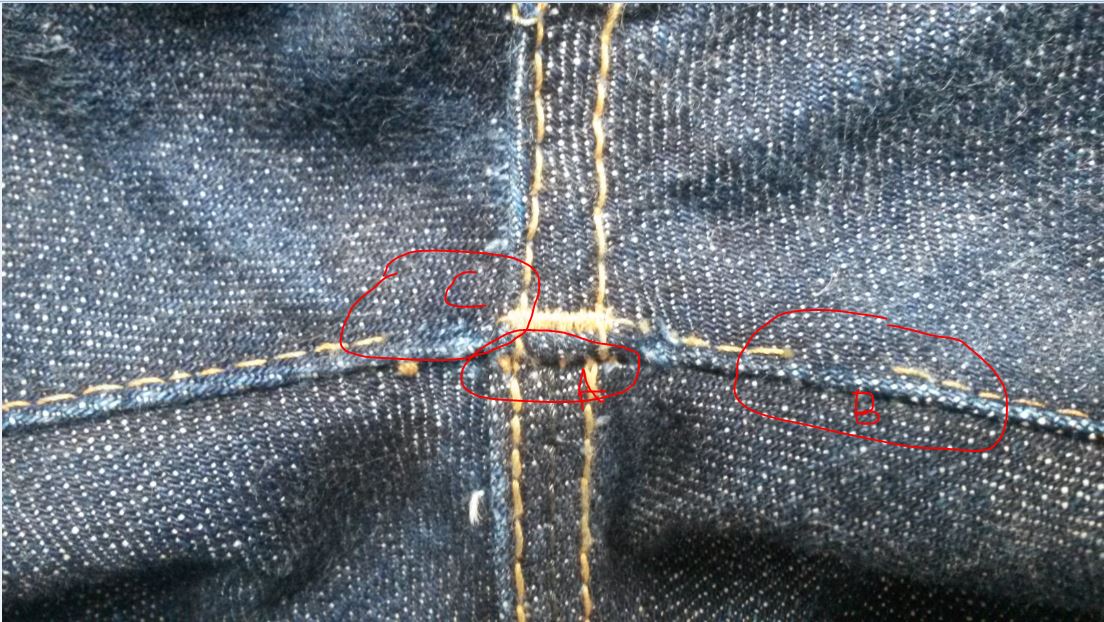Denim Durability Discussion: What lasts longer and why?
-
I just accept the damage as part of the process. I can either have the cuff fixed along with their first repairs, or use that opportunity to have them chopped and hemmed. It's definitely going to need consideration on my XHS, likely about when I need to repair the wearing crotch. The 666N though, show no sign
-
Jeans that don't fit as intended, are worn baggy for example, or too slim fitting jeans will increase the damage/stress on the crotch area. Have experienced this with crappy nonselvedge jeans and selvedge pairs.
-
hey guys, i been wearing this pair of samurais S003jps, for about 5 months, and I have noticed some seam splitting around the crotch area. I normally wouldn't bother but its happening around the crotch…. dammit
you can see the broken seams in the areas marked B and C. In the area marked A (where there is the double stitch, sorry for my shite paintshop writing), you can notice some separation beginning to happen between the top an bottom fabric.
The denim is still good, damage seems to only be with the cotton thread holding the fabric together. Stitching on the inside of the jeans seem fine tho…
sounds like arvo and megatron have similar issues. i was wondering if i should be bothered about this... do i need to get these repaired or is this all part and parcel of the cotton thread "aging" ? Last thing i want is the mouse to slip out the house one fateful day...
thanks for the replies
-
Very Slims cuts or Tapers cause a lot of knee stretching (bagging).
-
Potentially the most durable denim ever, Dyneema.
http://www.heddels.com/2016/05/dyneema-denim-promises-toughest-fabric-ever/
-
The denim may be more durable, but what about the stitching?
-
Some factors that I can add to the equation:
Washing - As a rule, jeans that have been washed regularly/semi-regularly in a machine with detergent, go longer than their unwashed, rarely washed, or cold-water soaked/hung dry counterparts. I find it a little bit silly that people are so bent about not "losing too much indigo" that they've got virtually unfaded jeans in need of massive crotch reconstruction.
Cut - Beyond jeans washed frequently the jeans that routinely achieve the most wear prior to needing their first repairs are more relaxed or at least have a top block with enough rise to facilitate a waist that tapers in from relatively roomy seat/thighs. The means that a good fit is possible without binding at the hips. The 634s is a good example of the trim side of this equation, whereas more traditional repro cuts are where we see this pattern time and time again. For example, we've seen lots of Sugar Cane 1947 and Mister Freedom Californians that have been very well worn prior to needing their first repairs (all the more impressive due to 100% cotton stitching…but if the stitching isn't being stressed at every movement....)
Fit - Sizing to hips and ass instead of the smallest waist size you can button up. Not only is the crotch a 3 dimensional stretch point that also has to contend with abrasion from legs rubbing together, it's the point that naturally takes the brunt of the ability for humans hips to expand when sitting/standing/squatting/running/walking/jumping. When jeans are sized very tightly across the hips/through the seat and thighs, instead of with room accommodating natural movement, the crotch will break down significantly more quickly than a "natural fit"
Starch/Stiffness/Rigidity - Correlates to the others in different ways, especially washing, but stiff, starchy fabric is more susceptible to abrasion, both external and self-inflicted. Creasing and pulling on rigid/brittle fabric also creates more extreme damage than a soft highly malleable fabric.
Slub/Weave Irregularity - I'm not going to pretend to be a textile art guru, BUT super slubby, slack woven, and otherwise highly irregular denims tend to break down quicker, and suffer from much more extreme/catastrophic blowouts that tighter, regular weaves. While this is highly anecdotal, in my experience, it seems that the levis and levis influenced denims from Cone and from japanese mills replicating cone are often very very durable relative to fabrics from brands like PBJ, Strike Gold, Oni Etc. Similarly, the 21oz sanforized denim from Iron Heart exhibits very strong behavior over the long term and is rarely in my experience the subject of catastrophic textile failure.
-
Agreed @tmadd. The trend to buy tighter fitting jeans so they don't stretch out in addition to the trend of already buying slim cuts… I'm a culprit of this very thing! I bought a pair of 301S a while back and slimmed down in buying my size. Thus an already slim fit was even more so
-
As one of the advocates of snug to really tight fits (and this consequently for as long as can think, not following some fad) I can only commend you @henry_david ! Concerns about durability are appropriate, but I would never sacrifice the kind of fit, and feel (!!!) that I like to make them longer lasting. Decay of denim, on the contrary, always has been a factor I absolutely love about jeans.
-
Thanks for the smorgasbord of information, and everybody that posted. I'd only add that regularly brushing the inside of the cuff out, to free it from pebbles and grain, should help enormously with destruction of integrity (unless you're cuffing them so low they drag!).





